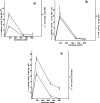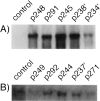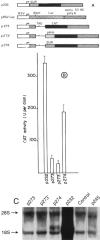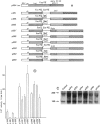Effect of intercistronic length on internal ribosome entry site (IRES) efficiency in bicistronic mRNA
- PMID: 10947079
- PMCID: PMC6157382
Effect of intercistronic length on internal ribosome entry site (IRES) efficiency in bicistronic mRNA
Abstract
Specific structures found in the mRNA of picornavirus are known to allow a cap-independent translation. These structures, named internal ribosome entry sites (IRES), are also able to favor translation of the second cistron in bicistronic mRNAs. Their mechanism of action is not well understood. In the present study, two IRESs have been used: the IRES from poliovirus and a newly discovered IRES (SUR) composed of the 5' P untranslated sequence from SV40 early genes, the R structure, and a small part of the U5 region from the human leukemia virus-1 (HTLV-1). The bicistronic constructs containing the firefly luciferase gene as the first cistron and the chloramphenicol acetyltransferase (CAT) as the second cistron were driven by the Rous sarcoma virus (RSV) promoter and contained the early gene SV40 terminator. All the resulting plasmids were tested by transfection in HeLa and CHO cells. In the bicistronic mRNAs without IRES, the expression of the CAT gene was dependent on the distance between the two cistrons. The maximum efficiency in the expression of the second cistron was obtained when the intercalating RNA was composed of 30 to 90 nucleotides. This expression was deeply reduced when the intercalating fragment contained 8 or 300 nucleotides and was undetectable with 500 nucleotides. Unexpectedly, the luciferase mRNA was almost not expressed when the intercalating RNA was of 8 or 30 nucleotides. Expression of the luciferase gene occurred when the intercistronic RNA fragment was of 80 nucleotides and it became lower at 300 and 500 nucleotides. The same observations were done when the poliovirus or the SUR IRESs were added after the intercistronic spacers. However, expression of the CAT gene was amplified by both IRESs. When the CAT cistron preceded by the poliovirus or SUR IRES was introduced within luciferase cistron, 316 nucleotides before its termination codon, the IRESs were able to initiate translation of the following CAT gene irrespectively of the mRNA luciferase reading frame. Moreover, with all these constructs the highest expression level of the CAT cistron did not exceed 10% of that obtained with the same vector carrying only the CAT cistron. To identify a possible relation between the IRESs and the cap site, the CAT cistron preceded or not with an IRES was introduced 210 nucleotides downstream of the AUG codon of the luciferase gene (i.e., 258 nucleotides from the cap site) and 100 nucleotides after an added UAG termination codon. Expression of the CAT gene was not modified by the addition of the poliovirus IRES but it was strongly stimulated by the SUR IRES (the level of expression corresponded to 65% of that obtained with the same vector carrying only the CAT cistron). These results suggest that there is a cooperation between the cap and the SUR IRES and not the poliovirus IRES to stimulate translation. These data indicate that IRESs must be introduced in precise position to allow an efficient expression of the second cistron in bicistronic mRNAs.
Figures






Similar articles
-
The optimal use of IRES (internal ribosome entry site) in expression vectors.Genet Anal. 1999 Nov;15(3-5):161-5. doi: 10.1016/s1050-3862(99)00021-2. Genet Anal. 1999. PMID: 10596757
-
Composition and arrangement of genes define the strength of IRES-driven translation in bicistronic mRNAs.Nucleic Acids Res. 2001 Aug 15;29(16):3327-34. doi: 10.1093/nar/29.16.3327. Nucleic Acids Res. 2001. PMID: 11504870 Free PMC article.
-
The efficiency of different IRESs (internal ribosomes entry site) in monocistronic mRNAS.Mol Biol Rep. 2000 Mar;27(1):21-6. doi: 10.1023/a:1007084730470. Mol Biol Rep. 2000. PMID: 10939522
-
Internal ribosome entry sites (IRESs): reality and use.Transgenic Res. 1999 Jun;8(3):157-77. doi: 10.1023/a:1008909908180. Transgenic Res. 1999. PMID: 10478488 Review.
-
Advances and Breakthroughs in IRES-Directed Translation and Replication of Picornaviruses.mBio. 2023 Apr 25;14(2):e0035823. doi: 10.1128/mbio.00358-23. Epub 2023 Mar 20. mBio. 2023. PMID: 36939331 Free PMC article. Review.
Cited by
-
Modifying inter-cistronic sequence significantly enhances IRES dependent second gene expression in bicistronic vector: Construction of optimised cassette for gene therapy of familial hypercholesterolemia.Noncoding RNA Res. 2018 Nov 22;4(1):1-14. doi: 10.1016/j.ncrna.2018.11.005. eCollection 2019 Mar. Noncoding RNA Res. 2018. PMID: 30891532 Free PMC article.
-
Recombinant Adeno-Associated Viral Vectors (rAAV)-Vector Elements in Ocular Gene Therapy Clinical Trials and Transgene Expression and Bioactivity Assays.Int J Mol Sci. 2020 Jun 12;21(12):4197. doi: 10.3390/ijms21124197. Int J Mol Sci. 2020. PMID: 32545533 Free PMC article. Review.
-
Metabolic engineering of Lactococcus lactis for high level accumulation of glutathione and S-adenosyl-L-methionine.World J Microbiol Biotechnol. 2019 Nov 14;35(12):185. doi: 10.1007/s11274-019-2759-x. World J Microbiol Biotechnol. 2019. PMID: 31728760
-
Translational control of Scamper expression via a cell-specific internal ribosome entry site.Nucleic Acids Res. 2003 May 15;31(10):2508-13. doi: 10.1093/nar/gkg357. Nucleic Acids Res. 2003. PMID: 12736299 Free PMC article.
-
Exploring new gene integration sites for gene knock-in by gene-trapping strategy.Transgenic Res. 2015 Jun;24(3):549-59. doi: 10.1007/s11248-015-9872-x. Epub 2015 Mar 31. Transgenic Res. 2015. PMID: 25822531
References
-
- Attal J.; Théron M. C.; Taboit F.; Cajero-Juarez M.; Kann G.; Bolifraud Ph.; Houdebine L. M. The RU5 (‘R’) region from human leukaemia viruses (HTLV-1) contains an internal ribosome entry site (IRES)-like sequence. FEBS Lett. 392:220–224; 1996. - PubMed
-
- Attal J.; Théron M. C.; Kann G.; Bolifraud P.; Puissant C.; Houdebine L. M. The stimulation to gene expression by the R region from HTLV-1 and BLV. J. Biotech, (in press). - PubMed
-
- Attal J.; Théron M. C.; Houdebine L. M. The optimal use of IRES (internal ribosome entry site) in expression vectors. Genet. Anal. Biomol. Eng. 13:161–165; 1999. - PubMed
-
- Chen C. Y.; Sarnow P. Initiation of protein synthesis by the eukaryotic translational apparatus on circular RNAs. Science 268:415–417; 1995. - PubMed
MeSH terms
Substances
LinkOut - more resources
Full Text Sources
Miscellaneous
